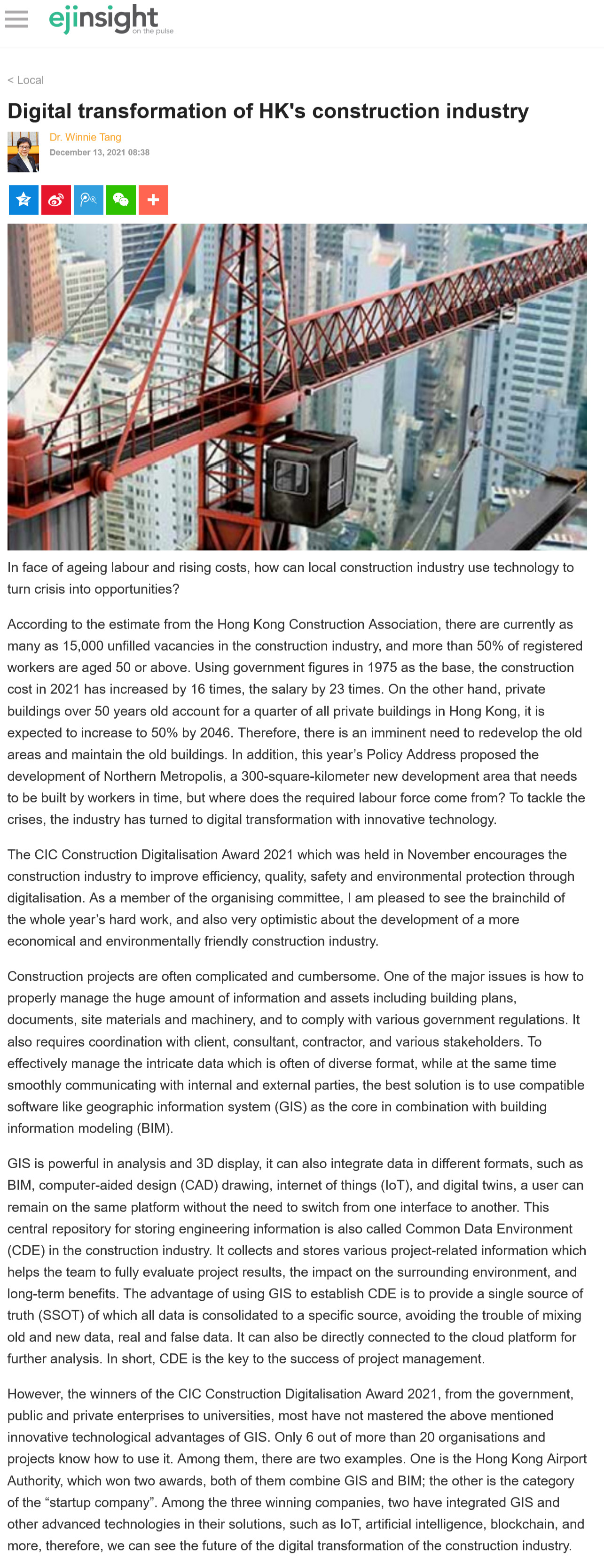網上版請按此

Digital transformation of HK's construction industry
In face of ageing labour and rising costs, how can local construction industry use technology to turn crisis into opportunities?
According to the estimate from the Hong Kong Construction Association, there are currently as many as 15,000 unfilled vacancies in the construction industry, and more than 50% of registered workers are aged 50 or above. Using government figures in 1975 as the base, the construction cost in 2021 has increased by 16 times, the salary by 23 times. On the other hand, private buildings over 50 years old account for a quarter of all private buildings in Hong Kong, it is expected to increase to 50% by 2046. Therefore, there is an imminent need to redevelop the old areas and maintain the old buildings. In addition, this year's Policy Address proposed the development of Northern Metropolis, a 300-square-kilometer new development area that needs to be built by workers in time, but where does the required labour force come from? To tackle the crises, the industry has turned to digital transformation with innovative technology.
The CIC Construction Digitalisation Award 2021 which was held in November encourages the construction industry to improve efficiency, quality, safety and environmental protection through digitalisation. As a member of the organising committee, I am pleased to see the brainchild of the whole year's hard work, and also very optimistic about the development of a more economical and environmentally friendly construction industry.
Construction projects are often complicated and cumbersome. One of the major issues is how to properly manage the huge amount of information and assets including building plans, documents, site materials and machinery, and to comply with various government regulations. It also requires coordination with client, consultant, contractor, and various stakeholders. To effectively manage the intricate data which is often of diverse format, while at the same time smoothly communicating with internal and external parties, the best solution is to use compatible software like geographic information system (GIS) as the core in combination with building information modeling (BIM).
GIS is powerful in analysis and 3D display, it can also integrate data in different formats, such as BIM, computer-aided design (CAD) drawing, internet of things (IoT), and digital twins, a user can remain on the same platform without the need to switch from one interface to another. This central repository for storing engineering information is also called Common Data Environment (CDE) in the construction industry. It collects and stores various project-related information which helps the team to fully evaluate project results, the impact on the surrounding environment, and long-term benefits. The advantage of using GIS to establish CDE is to provide a single source of truth (SSOT) of which all data is consolidated to a specific source, avoiding the trouble of mixing old and new data, real and false data. It can also be directly connected to the cloud platform for further analysis. In short, CDE is the key to the success of project management.
However, the winners of the CIC Construction Digitalisation Award 2021, from the government, public and private enterprises to universities, most have not mastered the above mentioned innovative technological advantages of GIS. Only 6 out of more than 20 organisations and projects know how to use it. Among them, there are two examples. One is the Hong Kong Airport Authority, which won two awards, both of them combine GIS and BIM; the other is the category of the "startup company". Among the three winning companies, two have integrated GIS and other advanced technologies in their solutions, such as IoT, artificial intelligence, blockchain, and more, therefore, we can see the future of the digital transformation of the construction industry.
Dr. Winnie Tang
Adjunct Professor, Department of Computer Science, Faculty of Engineering; Department of Geography, Faculty of Social Sciences; and Faculty of Architecture, The University of Hong Kong